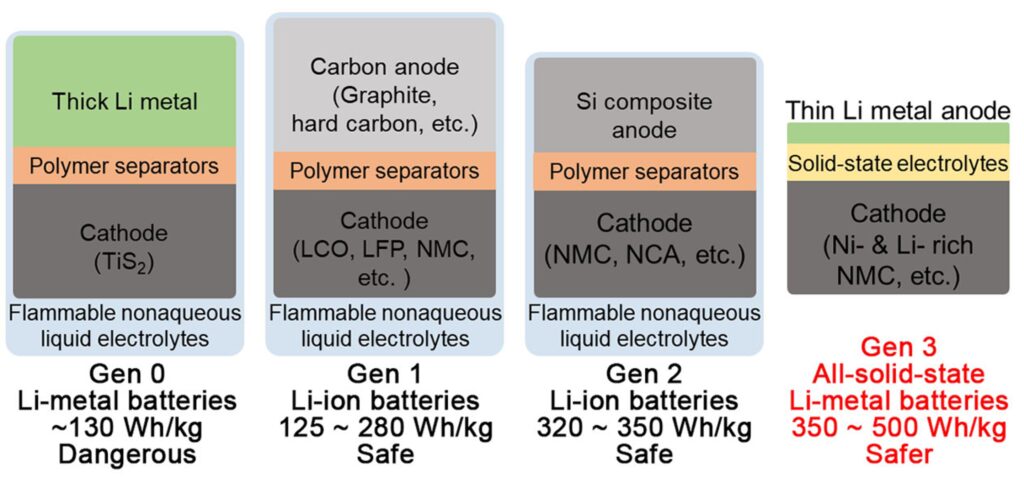All-solid-state lithium metal batteries (LMBs) are promising energy storage solutions that incorporate a lithium metal anode and solid-state electrolytes (SSEs), as opposed to the liquid ones found in conventional lithium batteries. While solid-state LMBs could exhibit significantly higher energy densities compared to lithium-ion batteries (LiBs), the solid electrolytes they contain are prone to dendrite growth, which reduces their stability and safety.
Researchers at Western University in Canada, University of Maryland in the United States and other institutes recently designed a new vacancy-rich, and superionic conducting β-Li3N solid-state electrolyte (SSE). The electrolyte, reported in a paper recently published in Nature Nanotechnology, could sustain stable cycling of all-solid-state LMBs, potentially facilitating their commercialization.
“The primary objective of our work was to develop lithium-stable, superionic conducting SSEs for all-solid-state LMBs, particularly targeting their application in electric vehicles (EVs),” Weihan Li, first author of the paper, told Phys.org.
“The EV market is experiencing rapid growth, but a key limitation remains the short driving range of 300–400 miles per charge, primarily due to the limited energy density (~300 Wh/kg) of conventional lithium-ion batteries. All-solid-state lithium metal batteries represent a promising solution to this challenge by offering the potential to achieve energy densities of up to 500 Wh/kg, thereby extending the driving range to over 600 miles per charge.”
So far, a key challenge in the development of all-solid-state LMBs has been the lack of safe, reliable and highly performing SSEs. The key objective of the recent work by Li and his colleagues was to design a new electrolyte that combines a high stability against lithium metal with a high ionic conductivity.
“Building on our prior understanding of SSEs, we identified nitrides as a class of materials that are stable against lithium metal,” said Li. “However, conventional nitrides exhibit low ionic conductivity. By leveraging our knowledge of lithium conduction mechanisms, we designed a vacancy-rich β-Li3N SSE.”
In initial tests, the new vacancy-rich β-Li3N SSE designed by this team of researchers demonstrated a 100-fold improvement in ionic conductivity and a greater stability compared to commercial Li3N. This promising material could thus help to overcome the limitations typically associated with the development of high-performance all-solid-state LMBs.
“Our design of the vacancy-rich β-Li3N was guided by an understanding of lithium-ion conduction mechanisms,” said Li. “Defects in the crystal structure, such as vacancies, can reduce the energy barriers for lithium-ion migration and increase the population of mobile lithium ions.”
The researchers synthesized the vacancy-rich β-Li3N SSE using a high-energy ball-milling process. This process was used to introduce a controlled number of vacancies into the material’s structure, which ultimately enhanced its properties.
“The ionic conductivity of vacancy-rich β-Li3N is 100 times greater than that of commercial Li3N,” explained Li. “It demonstrates excellent chemical stability against lithium metal, enabling the fabrication of long-cycling all-solid-state LMBs. The material also shows high stability in dry air, making it suitable for industrial-scale production in dry-room environments.”
When they integrated their newly designed SSE in an LMB, the researchers attained an unprecedented ionic conductivity for an SSE, reaching 2.14 × 10−3 S cm−1 at 25°C. Symmetric battery cells based on the electrolyte achieved high critical current densities up to 45 mA cm−2 and high capacities up to 7.5 mAh cm−2, as well as ultra-stable lithium stripping and plating processes over 2,000 cycles.
“Our study achieved record-breaking ionic conductivity and exceptional stability with lithium metal for a SSE,” said Li. “These findings are significant as they address two of the most critical challenges in the development of all-solid-state LMBs.”
The new material synthesized by this team of researchers could open new exciting possibilities for the fabrication of all-solid-state LMBs, potentially enhancing their energy density and speeding up their charging. These batteries could eventually be integrated into electric vehicles and other large electronics, to extend their battery life and reduce the time they need to charge.
“Moving forward, my research will focus on two main directions,” added Li. “On one hand, I aim to address the remaining interfacial challenges in all-solid-state LMBs to further enhance lithium-ion conduction and extend battery lifespan. This will involve in-depth investigations of interfacial reaction kinetics and novel material designs.
“On the engineering front, I plan to tackle practical challenges by developing prototype cells and commercial-scale pouch cells based on vacancy-rich β-Li3N. This will include optimizing the material for large-scale production and integrating it into functional battery systems suitable for real-world applications.”


